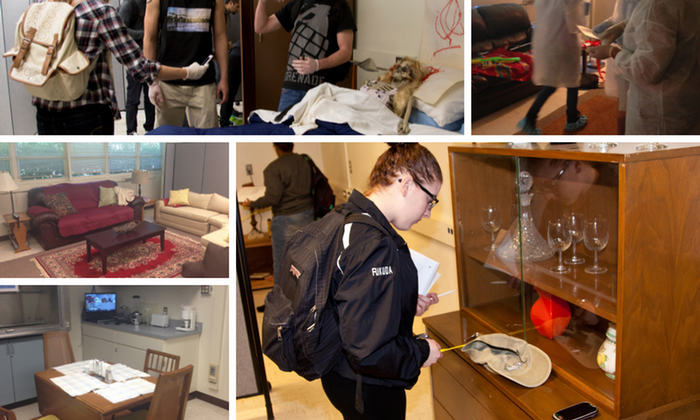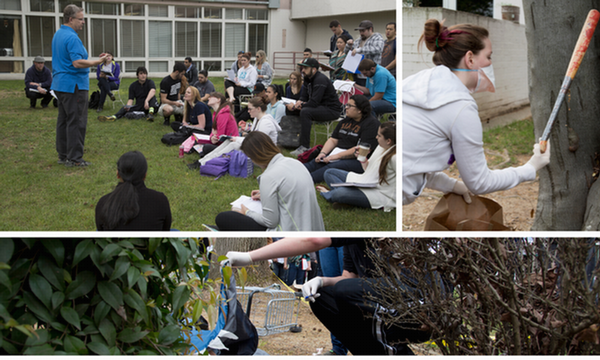Support Page Content
The Crime Scene Teaching Laboratory

The crime scene lab was opened by Chair Mary Maguire in 2013 to assist students and faculty in meeting the learning goals of investigative and policing courses. It was determined there was a need for practical exercises in classes such as:
- CRJ 4 General Investigative Techniques
- CRJ 152 Interviewing & Detection of Deception
- CRJ 153 Advanced Criminal Investigation
- CRJ 154 Introduction to Physical Evidence
- Other classes as needed
Dignitaries, students, and academic officials have toured the lab as an example of what can be accomplished if the need is there.
About the Lab
The lab is designed to represent a typical small residence complete with a kitchen, bedroom and family room. Other rooms can be created by moving partitions, furniture, fixtures, and personal items.
The instructors for these classes have devised systems where students are able to investigate a mock crime scene. Professors typically recreate a scene from their past work experiences and teach the students how to process it. Instructors can also replicate an interview room complete with video recording in order to teach interviewing and interrogation skills. The convenience of being able to quickly and easily modify the lab by moving partitions and furniture allows students to experience different scenarios.
Practical Uses of the Lab
Throughout the semester, the Advanced Criminal Investigations class may go through multiple scenes ranging in difficulty. This class is typically required to initiate investigations ranging from trespassing to an unattended death. These students may work on a crime scene file containing physical evidence logs, investigator’s notes, crime scene rough sketches, final “to scale” drawings, witness statements, suspect statements and waiver of rights, laboratory reports on submitted evidence, and other paperwork needed on a case. Their case is then presented to the professor who acts as the district attorney. The case may go to a mock trial where students testify about their investigation based on evidence obtained from the laboratory crime scene. The experience is as close to the real thing as possible.
Students who are not working in the lab can view and hear students inside the lab by means of four interior cameras, allowing them to learn through others’ experiences. Any event may be recorded and watched later to help reinforce best practices and identify mistakes. Mock interviews or interrogations can be videoed for educational purposes as well.
The lab has been generously equipped with items to investigate most crime scenes and detect evidence. This equipment includes cameras to take crime scene photos and evidence bags to collect and tag evidence to the more specialized equipment like a portable fingerprint fuming chamber and blood splatter kits. There is enough equipment to properly investigate almost any scene to a high standard of quality.
Professors with decades of practical experience teach the investigation classes. Some professors are current local law enforcement. The practical, hands-on experience that students get while in the Crime Scene laboratory leads to an unforgettable experience.
Beyond the Lab
As not all crimes are committed inside a perfectly temperature-controlled room, the lab is equipped to go mobile.
The instructors routinely stage mock crime scenes near the Alpine building. The same types of scenes (suspicious death, robbery, missing person) are investigated but with added elements, often things taken for granted that novice detectives or investigators, just learning their craft, sometimes do not take into account like wind and weather that make crime scene investigation more challenging. For this and other reasons, the faculty tries to stage at least one mock crime scene during the semester. It’s not as easy as TV programs like CSI would lead one to believe.
